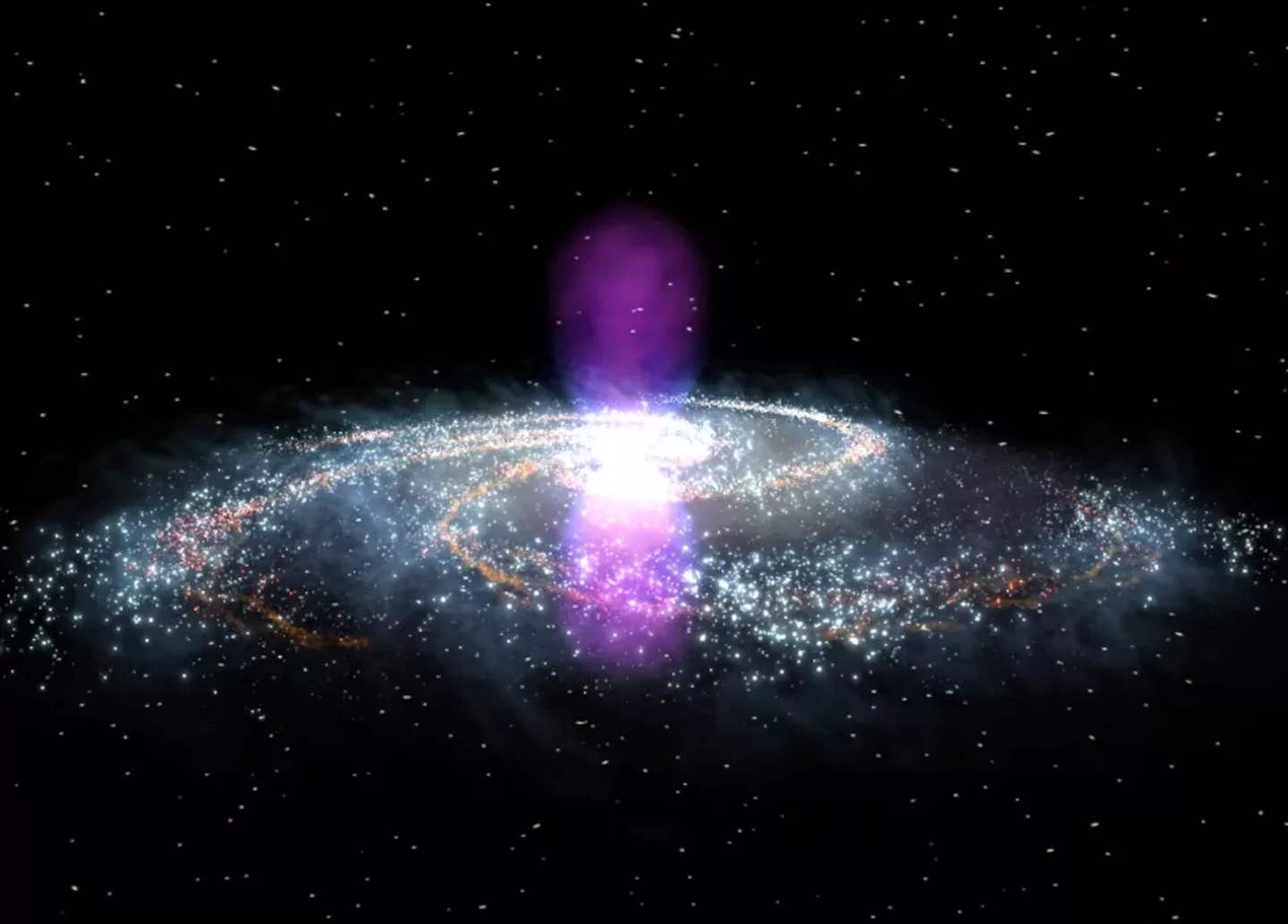Astronomers discovered Fermi bubbles hiding at the center of the Milky Way
Cold hydrogen clouds found in the Milky Way’s Fermi bubbles reveal these massive structures are younger than scientists believed.

Astronomers found cold hydrogen clouds deep inside the Milky Way’s Fermi bubbles. (CREDIT: CC BY-SA 4.0)
Deep within the Milky Way’s core, researchers have uncovered cold gas clouds racing through a superheated galactic wind. These clouds sit high above the plane of the galaxy, deep inside enormous plasma structures known as Fermi bubbles. The finding challenges older ideas about how these bubbles formed and how long they’ve existed.
The Fermi bubbles rise above and below the center of the Milky Way. They stretch across 50,000 light-years—about half the width of our entire galaxy. They were first detected in 2010 through NASA's Fermi Gamma-ray Space Telescope. Since then, scientists have debated how these massive outflows of gas began. Many suspect an ancient, explosive event near the Milky Way’s central black hole.
Cold Gas in a Hot Wind
Rongmon Bordoloi, a physicist at North Carolina State University, and his team used the Green Bank Telescope in West Virginia to peer deep into one part of the northern bubble. Their goal was to study how gas moves inside these structures. What they found shocked them. They detected 11 distinct high-velocity hydrogen clouds, moving between 90 and 180 kilometers per second, roughly 12,000 light-years above the galaxy’s center. These clouds were much colder than expected.
Most gas inside the Fermi bubbles measures over a million degrees Kelvin. But these clouds were only around 10,000 degrees—100 times cooler than their surroundings. Andrew Fox, an astronomer at the Space Telescope Science Institute, compared the contrast to "finding ice cubes in a volcano."
Their discovery relied on 21-centimeter radio waves, a signature emitted by neutral hydrogen gas. Thanks to the telescope’s deep sensitivity, the team was able to detect hydrogen column densities as low as 3.1 × 10¹⁷ atoms per square centimeter—more than twice as sensitive as any previous survey.
A Survival Mystery
These cold clouds should not exist in such an extreme place. Hot winds, moving near a million miles per hour, usually shred cooler material in just a few million years. That’s why this discovery reshapes our understanding of the Fermi bubbles’ age.
Related Stories
“If the Fermi bubbles were older than 10 million years, these clouds would’ve already been destroyed,” said Bordoloi. Their presence hints that the bubbles are surprisingly young—only a few million years old. That’s recent in cosmic terms. It means these structures weren’t even around when dinosaurs roamed Earth.
The clouds also align with a previously recorded ultraviolet sightline observed by the Hubble Space Telescope. That data revealed gas at several different temperatures, showing that the clouds are likely evaporating as they rise. “We’re seeing a mix of cold and hot gas, which fits what you'd expect when cooler clouds interact with hot winds,” Bordoloi explained.
Cloud Formation and Structure
Most of the 11 clouds observed were clearly resolved. They range from 4 to 28 parsecs across and carry up to 1,470 solar masses of gas. Several show signs of internal motion—velocity gradients that hint at ongoing disruption or pressure from surrounding hot gases. Scientists believe these clouds are fragments of larger structures, broken apart by the extreme conditions within the Fermi bubbles.
These new detections stand apart because they were found at unusually high galactic latitudes—between 25° and 30°—far above the galactic plane. Earlier hydrogen cloud discoveries inside the Fermi bubbles had all been found at lower latitudes, closer to the core.
These high-latitude clouds likely originated near the Milky Way’s center and were swept upward by the nuclear wind. As Jay Lockman of the Green Bank Observatory explained, “We can’t see the hot wind itself, but we can track its path by following the cold clouds it carries.”
Winds That Shape Galaxies
The nuclear wind at the heart of the Milky Way plays a major role in how matter and energy move through the galaxy. It helps regulate star formation, spreads heavy elements into the halo, and links the galactic core with its outer regions.
The wind contains multiple phases of gas. These include cold hydrogen clouds, carbon monoxide molecules, and highly ionized plasma. Studies over the past decade have shown that the Fermi bubbles contain all of these, with temperatures ranging from 100 to over 3 million degrees Kelvin.
The newly discovered clouds are part of that mix. Observed in 21 cm emission, they represent the neutral, cold phase of the wind. Other parts of the same structures have been tracked using ultraviolet metal lines, molecular hydrogen absorption, and X-ray emissions.
UV studies, including those by Bordoloi and others, have mapped the kinematics and chemistry of these clouds. Findings from previous work revealed that the wind forms a biconical structure, expanding outwards from the center of the Milky Way like twin volcanic plumes. This discovery fits that model, offering direct evidence of the cool matter being pulled upward.
A New Look at Galactic Feedback
Understanding these clouds sheds light on a bigger process called “galactic feedback.” That’s the way galaxies regulate themselves by pushing gas out from their centers. These outflows affect how galaxies grow and evolve over billions of years.
Right now, computer simulations of feedback are trying to predict how different types of gas—hot, cold, and ionized—move through space. The survival of cold gas in the Fermi bubbles places new constraints on these models. It means that cold clouds can last longer than expected, or that they form in ways we don’t yet understand.
“Our work provides a key benchmark for future simulations,” said Bordoloi. “It shows that real galactic winds can carry cold gas farther than we thought. That changes how we think about the life cycle of matter in the Milky Way and other galaxies.”
The study, published in Astrophysical Journal Letters, opens new paths for exploring galactic winds. It also connects radio and ultraviolet astronomy in a unique way. By studying the same clouds through different lenses, researchers get a fuller picture of what’s happening inside these giant, mysterious bubbles.
Note: The article above provided above by The Brighter Side of News.
Like these kind of feel good stories? Get The Brighter Side of News' newsletter.



